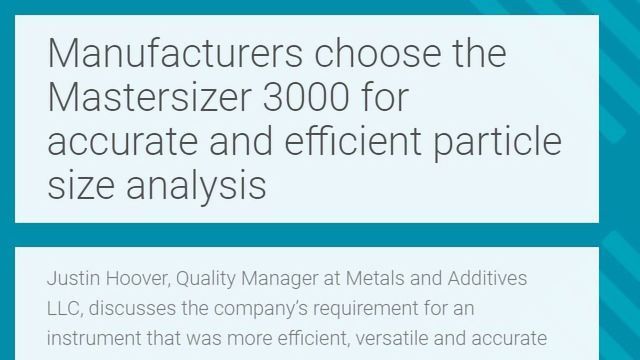Particle Size Analysis: The Science Behind It

The measurement of particle size is an essential aspect of many scientific disciplines, including materials science, chemical engineering, environmental science, and pharmaceuticals. Particle size analysis involves the accurate and reliable measurement of the size distribution of particles present in a sample.
HORIBA Scientific, a leading provider of particle size analyzers, provides a range of advanced technologies that enable accurate and reliable particle size distribution measurements from 0.3 nanometers to 30 millimeters. The company's state-of-the-art particle size analyzers are widely used in research, development, and quality control applications across several industries.
Why Is Particle Size Distribution Important?
The size distribution of particles in a sample can have a significant impact on the material's properties and behavior. Particle size distribution affects the chemical reaction rates, stability, and bioavailability of drugs, the flow properties of powders, and the efficiency of catalysts. Therefore, particle size analysis is crucial for industries like pharmaceuticals, food and beverages, chemicals, and materials science.
Accurate and reliable particle size distribution measurements help companies optimize their processes, ensure product quality, and meet regulatory requirements. Particle size analyzers are capable of detecting size ranges that are not visible to the naked eye and provide precise, quantitative data that helps researchers and engineers make informed decisions.
HORIBA Scientific's Particle Size Analyzers: Accuracy and Reliability
HORIBA Scientific's particle size analyzers provide reliable measurements across a wide range of particle sizes, from 0.3 nanometers to 30 millimeters. The company's technology is based on laser diffraction, dynamic light scattering, and image analysis, providing a comprehensive range of particle measurement techniques.
Laser diffraction is the most widely used particle sizing technique, and HORIBA Scientific's laser diffraction particle size analyzers provide fast, accurate, and reproducible measurements. The technology involves passing a sample through a laser beam and measuring the angle at which the scattered light is detected. The intensity of the scattered light is then analyzed to determine the particle size distribution.
Dynamic light scattering is a technique used for small particle sizing, and it is ideal for measuring particles in the nanometer range. The technology involves shining a laser beam onto a sample and measuring the changes in intensity of the scattered light. From this, the particle size distribution can be determined.
Image analysis is a technique that involves analyzing images of particles obtained using microscopy. HORIBA Scientific's image analysis particle size analyzer provides high-resolution images of the sample and automatic particle recognition to quickly and accurately determine the particle size distribution.
Applications of Particle Size Analysis
Particle size analysis is used in various industries to optimize processes, ensure product quality, and meet regulatory requirements. Some of the applications of particle size analysis include:
Pharmaceuticals: Particle size analysis is used to determine the physical and biological properties of drug formulations, such as the bioavailability and dissolution rate. It is also used to ensure the consistency of drug formulations during production.
Materials Science: Particle size analysis is used to examine the properties of materials such as powders, ceramics, and composites. It determines the size distribution of particles, which can affect the physical, mechanical, and electrical properties of the materials.
Chemicals: In the chemical industry, particle size analysis is used to optimize processes, such as crystallization, filtration, and precipitation. It can also detect impurities in products and ensure consistency in production.
Food and Beverages: Particle size analysis is essential in the food and beverage industry to optimize the texture, mouthfeel, and stability of food products such as emulsions, suspensions, and foams.
Conclusion
Particle size analysis is a crucial aspect of several scientific disciplines, and it plays a vital role in optimizing processes, ensuring product quality, and meeting regulatory requirements. HORIBA Scientific's particle size analyzers provide accurate and reliable measurements across a broad range of particle sizes, from 0.3 nanometers to 30 millimeters, using advanced laser diffraction, dynamic light scattering, and image analysis technologies. The company's particle size analyzers are used in various industries, including pharmaceuticals, chemicals, materials science, and food and beverages, to optimize processes and ensure product quality.